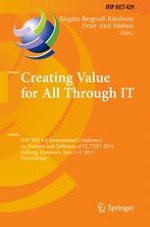2014 | Buch
Creating Value for All Through IT
IFIP WG 8.6 International Conference on Transfer and Diffusion of IT, TDIT 2014, Aalborg, Denmark, June 2-4, 2014. Proceedings
herausgegeben von: Birgitta Bergvall-Kåreborn, Peter Axel Nielsen
Verlag: Springer Berlin Heidelberg
Buchreihe : IFIP Advances in Information and Communication Technology
